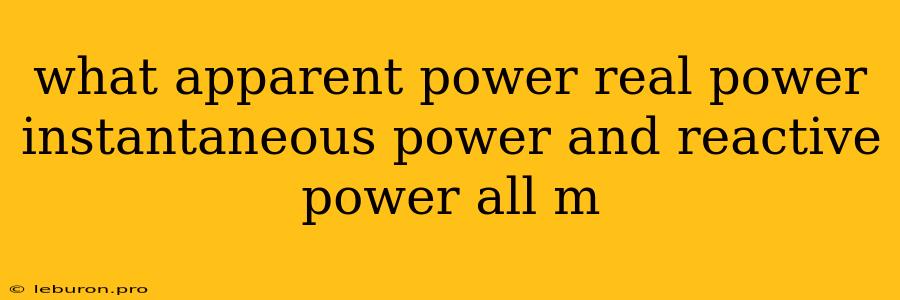In the realm of electrical engineering, understanding the different types of power is crucial for efficient system design and operation. While the term "power" might seem straightforward, it encompasses various forms, each playing a distinct role in electrical circuits. This article delves into the intricacies of apparent power, real power, instantaneous power, and reactive power, highlighting their definitions, relationships, and practical significance.
Apparent Power: The Total Power in a Circuit
Apparent power, often denoted by S, represents the total power flowing through a circuit, regardless of whether it's being consumed or returned to the source. It is calculated by multiplying the voltage (V) across the circuit by the current (I) flowing through it.
S = V × I
The unit for apparent power is volt-amperes (VA), highlighting its distinctness from real power.
Real Power: The Power Consumed by the Load
Real power, also known as active power, represents the actual power consumed by a load and converted into a useful form of energy, such as heat, light, or mechanical work. It's the portion of the apparent power that contributes to the actual work done in a circuit.
P = V × I × cos(θ)
Here, P represents real power, θ is the phase angle between the voltage and current waveforms, and cos(θ) is the power factor. Real power is measured in watts (W).
Instantaneous Power: The Power at a Specific Moment
Instantaneous power, denoted by p(t), represents the power consumed by a load at a specific moment in time. It is calculated by multiplying the instantaneous voltage v(t) and instantaneous current i(t) at that moment.
p(t) = v(t) × i(t)
Instantaneous power is essential for analyzing rapidly changing electrical signals and understanding the transient behavior of circuits.
Reactive Power: The Power Exchanged Between Source and Load
Reactive power, denoted by Q, represents the power that oscillates between the source and the load due to reactive components like capacitors and inductors. It's responsible for creating magnetic fields (in inductors) and electric fields (in capacitors).
Q = V × I × sin(θ)
Reactive power is measured in volt-amperes reactive (VAR). It does not contribute to the actual work done but is crucial for maintaining voltage levels and facilitating energy storage within the circuit.
The Power Triangle: A Visual Representation of Power Relationships
The power triangle provides a visual representation of the relationship between apparent power, real power, and reactive power. The apparent power (S) is the hypotenuse, while the real power (P) and reactive power (Q) form the legs of the right triangle.
!
The power factor, cos(θ), represents the ratio of real power to apparent power. It indicates the efficiency of power usage, with a power factor closer to 1 indicating a more efficient utilization of power.
Practical Significance of Power Types
Understanding the different types of power is crucial in various electrical applications, including:
- Power System Design: Engineers consider apparent power, real power, and reactive power when designing power systems to ensure efficient power distribution and minimize losses.
- Motor Operation: Reactive power is essential for motor operation as it creates the magnetic fields necessary for rotation.
- Power Factor Correction: Improving the power factor through techniques like capacitor banks can reduce losses and improve overall system efficiency.
Conclusion
In conclusion, apparent power, real power, instantaneous power, and reactive power are fundamental concepts in electrical engineering, each playing a distinct role in the operation and performance of electrical systems. Understanding these power types is crucial for designing efficient, reliable, and cost-effective electrical systems. While apparent power represents the total power in a circuit, real power reflects the actual power consumed by the load. Instantaneous power captures the power at a specific moment in time, while reactive power oscillates between the source and load, contributing to energy storage and magnetic field creation. By carefully analyzing and managing these different types of power, electrical engineers can optimize system performance and ensure safe and efficient electrical operation.
